Albert Francis King, an American painter born in the bustling industrial heartland of Pittsburgh, Pennsylvania, in 1854, carved a distinguished niche for himself in the annals of American art. Over a career that spanned into the mid-20th century until his passing in 1945, King became renowned primarily for his exquisite still-life paintings, particularly his luscious and meticulously rendered depictions of fruit. His work, characterized by its rich color, tactile realism, and masterful handling of light, offers a vibrant testament to the enduring appeal of the still-life genre and secured his place as one of Pittsburgh's most beloved and prolific artists.
Early Life and Artistic Awakening in Pittsburgh
Born into a rapidly industrializing Pittsburgh, Albert Francis King's early environment was one of burgeoning commerce and technological advancement. However, it was the world of art that captured his imagination. While largely self-taught, a common path for many American artists of his generation, King did receive formal instruction from a key figure in the Pittsburgh art scene, Martin B. Leisser. Leisser, a respected local painter and teacher, would have provided King with foundational skills in drawing and painting, likely exposing him to traditional European artistic conventions and the importance of keen observation.
Pittsburgh, during King's formative years, was beginning to cultivate its own artistic identity. The city's growing wealth, derived from its iron and steel industries, led to an increase in patronage for the arts. This emerging cultural environment provided a supportive, if somewhat isolated, backdrop for young artists like King to develop their talents. His decision to focus on still life, a genre with a long and venerable history dating back to the Dutch Golden Age, allowed him to hone his technical skills to a remarkable degree, capturing the subtle interplay of light, color, and texture with extraordinary fidelity.
The Allure of Still Life: Style and Subject Matter
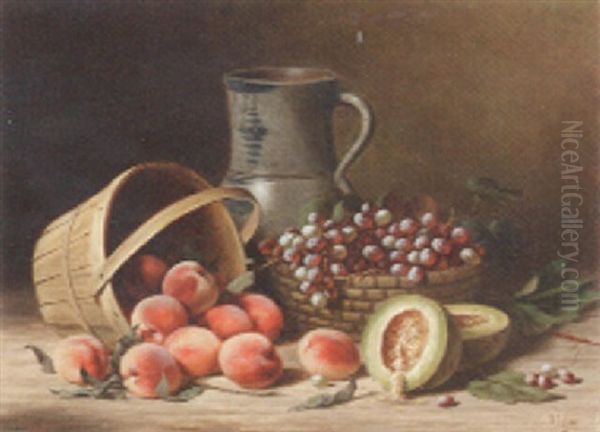
Albert Francis King's artistic output was dominated by still-life compositions, and within this genre, he demonstrated a particular fondness for fruit. His canvases frequently overflow with succulent peaches, glistening grapes, dewy plums, vibrant cherries, and the rich, patterned rinds of watermelons. These were not mere botanical studies; King imbued his subjects with a sense of abundance and an almost palpable appeal. His ability to render the soft fuzz of a peach, the taut skin of a grape, or the cool, moist flesh of a cut watermelon was exceptional.
His style was rooted in realism, emphasizing accurate representation and meticulous detail. King possessed a keen eye for the effects of light, using it to model his forms, create depth, and highlight the varied textures of his subjects. His palette was typically rich and warm, enhancing the natural vibrancy of the fruits he depicted. Unlike some of his contemporaries who ventured into the more illusionistic realms of trompe-l'oeil, such as William Michael Harnett or John F. Peto, King's realism was more direct and less concerned with optical trickery. His aim was to present the inherent beauty of his subjects in a straightforward yet highly refined manner.
While fruit was his dominant theme, King also painted other still-life subjects, including fish and game, and occasionally ventured into portraiture and landscape painting. However, it is his fruit still lifes that define his legacy and showcase his most accomplished work. These paintings found considerable favor with Pittsburgh's affluent merchant class, who appreciated their decorative qualities and the technical skill they displayed.
Influences and Artistic Context
King's dedication to realism places him within a strong tradition in American art. The 19th century saw a flourishing of still-life painting in the United States, with early masters like Raphaelle Peale and James Peale laying the groundwork. By the mid-to-late 19th century, artists such as Severin Roesen, known for his opulent and overflowing fruit and flower compositions, had gained considerable popularity. While direct lines of influence can be difficult to trace definitively, it is likely that King was aware of Roesen's work, as well as the broader European still-life tradition, particularly the Dutch masters of the 17th century like Willem Kalf or Jan Davidsz. de Heem, whose influence permeated academic art training.
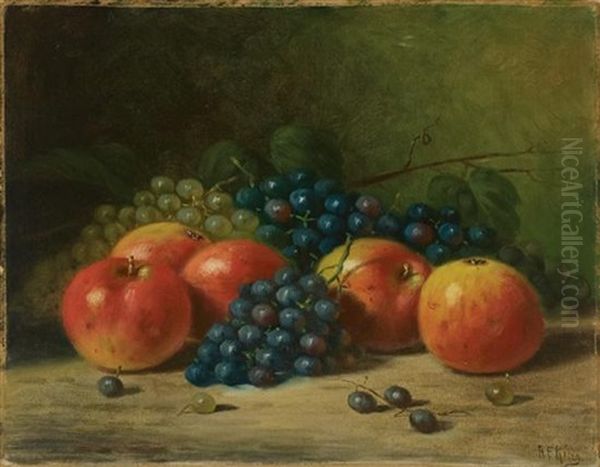
The precision and clarity in King's work also echo the general tenor of American Luminism, a mid-19th-century landscape painting style characterized by its meticulous detail and serene light, although King applied these principles to a different genre. He operated somewhat outside the major avant-garde movements of his time, such as Impressionism, which was gaining traction in Europe and America through artists like Claude Monet and Mary Cassatt. King remained steadfast in his commitment to a more traditional, realistic approach, which resonated well with his regional audience.
His contemporaries in the broader American art scene included figures like Winslow Homer, known for his powerful marine subjects and scenes of rural life, and Thomas Eakins, whose unflinching realism in portraiture and genre scenes often courted controversy. While their subject matter and, in some cases, their artistic philosophies differed, they all shared a commitment to observing and representing the world around them with a degree of truthfulness, albeit interpreted through their individual artistic visions.
The Scalp Level School and Pittsburgh's Artistic Milieu
Albert F. King was an active participant in the Pittsburgh art community and is often associated with the Scalp Level School, a group of artists who, beginning in the 1860s, frequently traveled to the scenic area of Scalp Level, near Johnstown, Pennsylvania, to paint landscapes en plein air. Leading figures of this informal school included George Hetzel, often considered its founder, Jasper Lawman, Alfred S. Wall, Joseph R. Woodwell, and Martin B. Leisser, King's own teacher.
While King was known more for his studio-based still lifes than for plein air landscapes, his association with these artists indicates his integration into the local artistic fraternity. The Scalp Level artists shared a common interest in capturing the natural beauty of the Pennsylvania landscape, and their camaraderie likely fostered a supportive environment for artistic development. King's participation in this circle, even if his primary output differed, would have exposed him to ongoing discussions about technique, subject matter, and the role of the artist.
He was a charter member of the Associated Artists of Pittsburgh (AAP), founded in 1910, which became a significant organization for promoting local artists and exhibiting their work. King regularly exhibited with the AAP, and his paintings were consistently popular. His involvement underscores his commitment to the professionalization of the arts in Pittsburgh and his desire to engage with his fellow artists.
Representative Works and Artistic Signature
Identifying specific, universally recognized titles for Albert Francis King's works can be challenging, as he was incredibly prolific and often painted similar arrangements of fruit with subtle variations. Many of his paintings are titled descriptively, such as "Still Life with Peaches," "Watermelon and Grapes," "Basket of Plums," or "Cherries in a Glass Bowl."
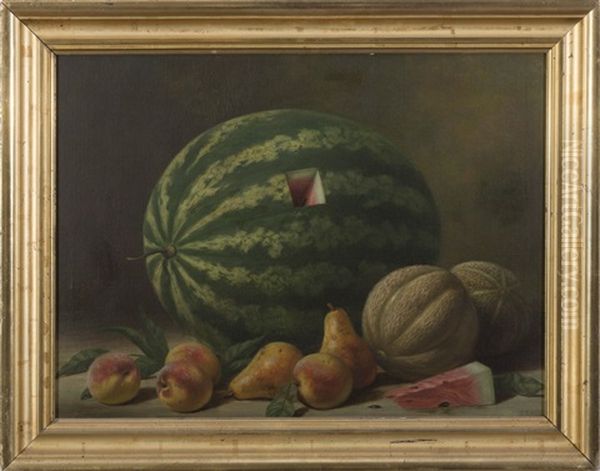
A quintessential Albert Francis King painting would typically feature a tabletop arrangement of fruit, often spilling from a basket or bowl, or simply clustered together. For instance, a "Still Life with Peaches and Grapes" would showcase his ability to capture the velvety texture of the peaches, contrasting with the smooth, translucent globes of the grapes. He often included dewdrops on the fruit, a classic still-life motif used to demonstrate technical virtuosity and enhance the sense of freshness.
In his depictions of watermelon, such as "A Slice of Watermelon," King excelled at rendering the crisp, crystalline texture of the fruit's flesh, the glossy black seeds, and the variegated pattern of the rind. These works are a feast for the eyes, inviting the viewer to almost taste the sweetness of the fruit. His compositions were generally well-balanced, with a clear focus on the central subject, often set against a dark, neutral background that allowed the colors of the fruit to stand out vividly. The play of light across the surfaces – a highlight on a grape, a shadow defining the curve of an apple – was always handled with subtlety and precision.
Later Career and Enduring Legacy
Albert Francis King continued to paint and exhibit throughout his long career, remaining a popular and respected figure in Pittsburgh. His dedication to his craft and his consistent output ensured that his works became fixtures in many local collections, both private and public. He witnessed significant changes in the art world, from the rise of Impressionism and Post-Impressionism to the advent of Modernism with figures like Pablo Picasso and Henri Matisse revolutionizing artistic expression. Yet, King largely remained true to his realistic style, which continued to find an appreciative audience.
His legacy is primarily that of a master of still-life painting within the American realist tradition. While he may not have been an innovator in the modernist sense, his technical skill, his sensitive depiction of natural forms, and the sheer beauty of his canvases have ensured his enduring appeal. His paintings offer a window into the aesthetic preferences of his time and place, reflecting a love for the tangible beauty of the everyday world.
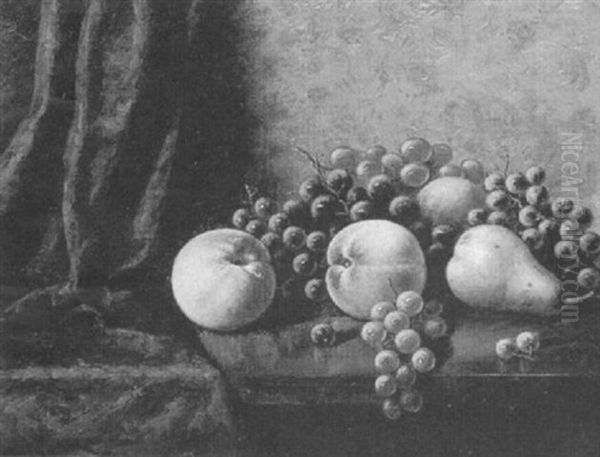
Today, Albert Francis King's works are held in numerous private collections and can be found in museums, particularly those with a focus on American art or regional Pennsylvania artists, such as the Westmoreland Museum of American Art and the Carnegie Museum of Art in Pittsburgh. His paintings continue to be admired for their technical brilliance, their vibrant celebration of nature's bounty, and their quiet, unassuming charm. He stands as a testament to the lasting power of representational art and as a significant contributor to Pittsburgh's rich artistic heritage, a peer to other notable Pennsylvania artists of his era like Thomas Anshutz or Cecilia Beaux, though their primary genres differed.
Exhibitions and Recognition
Throughout his career, Albert Francis King was a consistent exhibitor, primarily in Pittsburgh and the surrounding region. His most significant and regular venue was the Associated Artists of Pittsburgh's annual exhibitions. The AAP provided a crucial platform for local artists to showcase their work to the public and to fellow artists. King's still lifes were perennial favorites at these shows, often praised for their technical skill and appealing subject matter.
While he may not have sought or achieved the national fame of some of his East Coast contemporaries, his reputation within Pennsylvania, and particularly in Pittsburgh, was solid. His work was acquired by local collectors and institutions, signifying a sustained level of appreciation and patronage. The fact that his paintings continue to appear in art auctions and are sought after by collectors today speaks to the lasting quality of his work.
The historical context of his exhibitions is important. In the late 19th and early 20th centuries, regional art societies and annual exhibitions played a vital role in the cultural life of American cities. They were the primary means by which artists could gain visibility and sell their work, especially for those who did not or could not regularly exhibit in major art centers like New York or Philadelphia. King's consistent participation and success in such venues highlight his status as a leading professional artist in his community. His work, though perhaps not as widely known as that of, for example, the landscape painter George Inness or the portraitist John Singer Sargent on a national scale, held significant regional importance.
Conclusion: The Timeless Appeal of King's Art
Albert Francis King's contribution to American art lies in his mastery of the still-life genre and his unwavering commitment to realistic representation. In a career that spanned decades of profound artistic change, he remained dedicated to capturing the beauty and abundance of the natural world with remarkable skill and sensitivity. His luscious depictions of fruit, rendered with meticulous attention to detail, color, and light, continue to delight viewers and stand as a testament to his artistic talent.
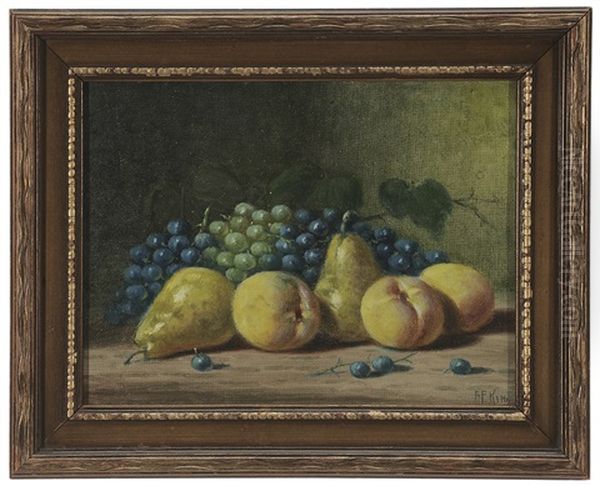
As a key figure in the Pittsburgh art scene and an associate of the Scalp Level School, King played an important role in the cultural development of his region. His prolific output and the consistent quality of his work earned him the admiration of his contemporaries and a lasting place in the collections of art lovers. While the grand narratives of art history often focus on radical innovation, the enduring appeal of artists like Albert Francis King reminds us of the profound satisfaction and beauty to be found in the skillful and heartfelt depiction of the world around us. His canvases are a quiet celebration, inviting us to pause and appreciate the simple, yet exquisite, gifts of nature, immortalized through the artist's discerning eye and accomplished hand.